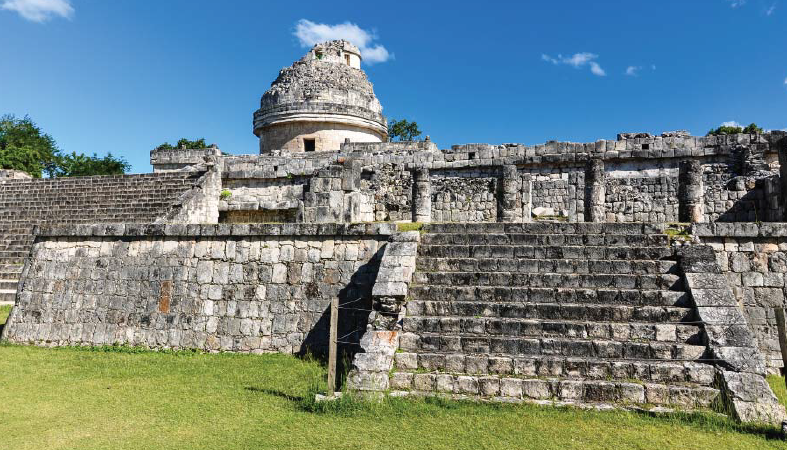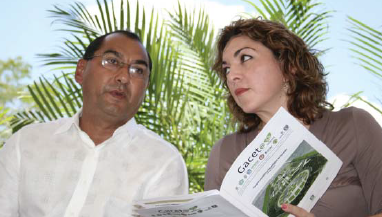Aligning Scientific Efforts in Mexico
The state of Yucatán uses local policies to promote science and technology.
Published August 1, 2012
By Raul Godoy-Montañez and Alfonso Larqué-Saavedra
Academy Contributors

The state of Yucatán in Mexico is widely known as the land of the classic Mayan ruins of Uxmal and Chichén Itzá. While Yucatán is characterized by age-old cultural traditions, the past does not define this area that is home to 2 million people. Yucatecan society has long recognized the importance of technology in creating a better future for its residents.
In 1852, the Yucatán governor requested 2,000 pesos from the President for the development of a machine that could extract fiber from the leaves of the henequen plant (Agave fourcroydes Lem.). This mechanization enabled the extension of the henequen industry through the establishment of large plantations and a processing industry within the hacienda system—all of which had a tremendous impact on the economic development of Yucatán.
Today, Yucatán boasts more than 1,000 science researchers, including members of the Mexican Academy of Sciences. It has several institutions dedicated to the development of scientific research, including the state university, a technological institute, centers belonging to the National Council of Science and Technology, and campuses of out-of-state institutions, such as the National Autonomous University of Mexico and the Center of Research and Advanced Studies of the National Polytechnic Institute. The best-known features of scientific interest in the state are the Chicxulub Crater, the Mayan culture, the peninsular aquifer, and the area’s biodiversity.
While such natural resources bring a wealth of potential development opportunities to Yucatán, researchers and government leaders realized that the impact of nearby technological and scientific institutions could be bolstered if the institutions’ goals and resources were better aligned.
Creating a Hub for S&T
To this end, in May 2008, the System of Research, Innovation and Technological Development of Yucatán (SIIDETEY) was created, integrating the ten most important federal and local public institutions in the state. The aim of SIIDETEY is to make Yucatán a “pole” for the development of science and technology in the Mexican Southeast, the Caribbean, and Central American countries, thereby attracting students and the establishment of technology-based companies.
SIIDETEY is a governance model with no cost to the State. It is an agreement between the Rectors and Directors of institutions belonging to the System with the aim of bringing together the capacities of its members in favor of science and technology. It is coordinated by the Secretary of Local Education, who acts as a promoter of the model.
The two main objectives of this System are to facilitate the development of joint research projects dealing with topics of interest for Yucatán and to serve as a liaison with the State and other national and international agencies in order to obtain the necessary funding to boost the development of science and technology.
Initially, SIIDETEY defined the most important research fields for the State as the development of the Mayan people, coastal development, water, health, food, education, energy, and habitat. The focal points for each of the fields were also identified. For example, in the field of water, the conservation of the peninsular aquifer was of prime interest. SIIDETEY is now establishing joint academic institutional programs to tackle these priorities, such as a program promoting renewable energy sources.
Financial Successes

Within the SIIDETEY model, the State has agreed to finance the Science and Technology Park of Yucatán and the construction of various laboratories. The SIIDETEY laboratories were conceived to serve both students and researchers in fields such as biomaterials, nanotechnology, biotechnology, coastal engineering, food processing, and renewable energy. A seed bank will also be financed.
One hundred and two hectares were ceded for the establishment of the Science and Technology Park of Yucatán, within which the SIIDETEY laboratories and the facilities required for the programs of member institutions will be built, along with other technology-based companies. For its second stage, the Park has been offered a further 100 hectares to promote, preferably, the establishment of additional companies.
SIIDETEY has made significant progress in obtaining financial resources. The resources gathered for the funding of research projects since the establishment of SIIDETEY four years ago are approaching $25 million. Construction has also begun on the Science and Technology Park and the laboratories with an initial investment of $40 million. It is estimated that, by the year 2018, the Park will be providing services to at least 300 researchers and 1,000 postgraduate students.
The financial resources obtained for science and technology in Yucatán over the last four years are unprecedented, and also very welcome, since it is in the Mexican Southeast where a significant portion of the country’s natural and cultural wealth (oil fields, water features, and biological and cultural diversity) is located.
Scientific and Political Support
Since its creation, SIIDETEY has received the permanent support of the National Council of Science and Technology, whose members have also established programs to provide the industrial sector with seed capital, and to coordinate—through technological development projects—with the academic sector. The constant improvement of the business sector and the establishment of new technology-based companies will in turn generate new jobs, thanks to the achievements of the SIIDETEY model.
Due to the vision proposed and the progress achieved, the model has recently received the unanimous approval of representatives from the different political parties comprising the local Congress, who have provided legal justification for the existence of SIIDETEY and the Science and Technology Park of Yucatán.
Although there is still an urgent need for the decentralization of science in Mexico in order to multiply the current capacity of the country, efforts to align the work of various scientific institutions have begun to gain momentum. The initiative taken by the small state of Yucatán has allowed a new plan to emerge in Mexico, facilitating the transition to a knowledge-based economy. The promotion of science by the local government and institutions will surely stimulate and strengthen the regional economy and generate more opportunities for the next generation.
This story originally appeared in the Summer 2012 issue of The New York Academy of Sciences Magazine.
